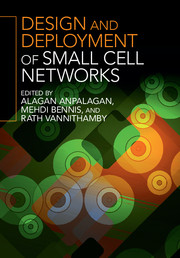Book contents
- Frontmatter
- Contents
- List of contributors
- Preface
- 1 Mobility performance optimization for 3GPP LTE HetNets
- 2 Design and performance analysis of multi-radio small cell networks
- 3 Dynamic TDD small cell management
- 4 3GPP RAN standards for small cells
- 5 Dense networks of small cells
- 6 Traffic offloading scenarios for heterogeneous networks
- 7 Required number of small cell access points in heterogeneous wireless networks
- 8 Small cell deployments: system scenarios, performance, and analysis
- 9 Temporary cognitive small cell networks for rapid and emergency deployments
- 10 Long-term evolution (LTE) and LTE-Advanced activities in small cell networks
- 11 Game theory and learning techniques for self-organization in small cell networks
- 12 Energy efficient strategies with BS sleep mode in green small cell networks
- 13 Mobility management in small cell heterogeneous networks
- 14 The art of deploying small cells: field trial experiments, system design, performance prediction, and deployment feasibility
- 15 Centralized self-optimization of interference management in LTE-A HetNets
- 16 Self-organized ICIC for SCN
- 17 Large-scale deployment and scalability
- 18 Energy efficient heterogeneous networks
- 19 Time- and frequency-domain e-ICIC with single- and multi-flow carrier aggregation in HetNets
- Index
- References
3 - Dynamic TDD small cell management
Published online by Cambridge University Press: 05 December 2015
- Frontmatter
- Contents
- List of contributors
- Preface
- 1 Mobility performance optimization for 3GPP LTE HetNets
- 2 Design and performance analysis of multi-radio small cell networks
- 3 Dynamic TDD small cell management
- 4 3GPP RAN standards for small cells
- 5 Dense networks of small cells
- 6 Traffic offloading scenarios for heterogeneous networks
- 7 Required number of small cell access points in heterogeneous wireless networks
- 8 Small cell deployments: system scenarios, performance, and analysis
- 9 Temporary cognitive small cell networks for rapid and emergency deployments
- 10 Long-term evolution (LTE) and LTE-Advanced activities in small cell networks
- 11 Game theory and learning techniques for self-organization in small cell networks
- 12 Energy efficient strategies with BS sleep mode in green small cell networks
- 13 Mobility management in small cell heterogeneous networks
- 14 The art of deploying small cells: field trial experiments, system design, performance prediction, and deployment feasibility
- 15 Centralized self-optimization of interference management in LTE-A HetNets
- 16 Self-organized ICIC for SCN
- 17 Large-scale deployment and scalability
- 18 Energy efficient heterogeneous networks
- 19 Time- and frequency-domain e-ICIC with single- and multi-flow carrier aggregation in HetNets
- Index
- References
Summary
In contrast to voice traffic, wireless data traffic is mostly asymmetric and time-variant with a requirement for a dynamically adjusting technique to divide the uplink (UL) and downlink (DL) resource. In typical cellular systems, the length of UL resource and the length of DL resource are predetermined. In a typical frequency-division duplex (FDD) system, the UL and DL transmission use distinctive frequency bands, which is especially efficient in cases of symmetric traffic due to the avoidance of possible interference between UL and DL transmission. However the FDD system has difficulty in adjusting its UL and DL resource in asymmetric traffic since the resource division is operated by the duplexer in the hardware. A typical time-division duplex (TDD) system is capable of adjusting the UL and DL transmission in time domain. However, due to the requirement of synchronization in order to eliminate the interference, the UL and DL resource is still fixed. To support asymmetric and time-variant traffic, LTE provides small cell base stations (BSs) with dynamic TDD by supporting seven TDD UL/DL configurations, enabling the BSs dynamically to change the ratio of UP and DL resource to handle the time-variant traffic. Nevertheless, such a scheme also induces two type of interference: BS–BS interference and MS–MS interference. In this chapter the interference issues and several interference mitigation methods will be extensively discussed.
Dynamic TDD system overview
Introduction
To divide the UL and DL traffic resource, some typical communication systems apply FDD, where different frequency bands are used for transmitting and receiving, the benefit of which is that no interference will be incurred between UL and DL signals. For the symmetrical traffic on UL and DL (e.g., voice service), the FDD system is suitable since the BS is assigned the same amount of radio resource in the UL and DL. Whereas for wireless data services, FDD is not flexible enough to handle this type of dynamic UL/DL traffic due to the character of the UL and DL traffic being asymmetric and time-variant in these cases.
Compared to FDD, TDD is different in that the UL and DL resource is divided in time domain and can be easily adjusted. It possesses an advantage of greater flexibility in handling the dynamic UL/DL traffic. In the TDD system, the boundary between the UL and DL duty cycle is adaptively adjustable according to service requirements.
- Type
- Chapter
- Information
- Design and Deployment of Small Cell Networks , pp. 58 - 74Publisher: Cambridge University PressPrint publication year: 2015



